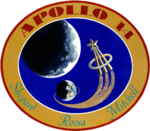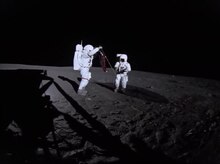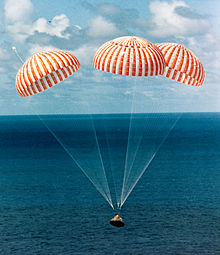Apollo 14
| Mission emblem | |||
|---|---|---|---|

|
|||
| Mission dates | |||
| Mission: | Apollo 14 | ||
| COSPAR-ID : | 1971-008A | ||
| Command module: | CM-110 | ||
| Service module: | SM-110 | ||
| Lunar Module: | LM-8 | ||
| Launcher: |
Saturn V , serial number SA-509 |
||
| Call sign: | CM: Kitty Hawk LM: Antares |
||
| Crew: | 3 | ||
| Begin: | January 31, 1971, 21:03:02 UTC JD : 2440983.3771065 |
||
| Starting place: | Kennedy Space Center , LC-39A | ||
| Number of EVA : | 2 | ||
| Moon landing: | February 5, 1971, 09:18:11 UTC JD : 2440987.8876273 |
||
| Landing site moon: |
Fra-Mauro 3 ° 38 ′ 43.08 ″ S , 17 ° 28 ′ 16.9 ″ W. |
||
| Length of the lunar EVAs: | 9h 21min | ||
| Time on the moon: | 1d 9h 30min 31s | ||
| Start from the moon: | February 6, 1971, 18:48:42 UTC JD : 2440989.2838194 |
||
| Lunar orbits: | 34 | ||
| Landing: | February 9, 1971, 21:05:00 UTC JD : 2440992.3784722 |
||
| Landing place: |
Pacific 27 ° 1 ′ S , 172 ° 40 ′ W |
||
| Flight duration: | 9d 0h 1min 58s | ||
| Recovery ship: | USS New Orleans | ||
| Team photo | |||
 Apollo 14 - v. l. No. Stuart Roosa , Alan Shepard , Edgar Mitchell |
|||
| ◄ Before / After ► | |||
|
|||
Apollo 14 was a manned flight to the moon as part of the US Apollo program .
crew
On August 6, 1969, shortly after the successful moon landing by Apollo 11 , NASA announced the crews for the Apollo 13 and Apollo 14 missions .
It had already been decided internally that Mercury veteran Alan Shepard would command one of the next moon flights. He had been the first American in space in 1961, even though his ballistic flight with Mercury-Redstone 3 lasted only 15 minutes and did not go into orbit; Because of this fact, the Apollo 14 crew was half-jokingly referred to as the first crew of all newbies. Shepard had been denied the ability to fly due to Menière's syndrome , an ear pressure disease , but he was able to become active again after an inner ear surgery.
Shepard was initially designated as the Apollo 13 commander at the expense of Gordon Cooper , who had hoped for a nomination as the Apollo 10 replacement commander . But then it was decided that Shepard should take over Apollo 14 to give him more time to prepare. The command of Apollo 13 did not go to Cooper, of course, but to Jim Lovell , who had previously trained for Apollo 14 with his crew. Cooper left NASA shortly afterwards.
Stuart Roosa was assigned as the pilot of the Apollo 14 command module , who was given preference over Donn Eisele . Eisele, like Cooper, had belonged to the backup team of Apollo 10 and would therefore normally have been nominated for the main team of Apollo 14.
Pilot of the lunar module was Edgar Mitchell after James McDivitt (serving as commander of Gemini 4 and Apollo 9 was much more experienced than space Shepard) this position had declined. Both Roosa and Mitchell were from the fifth astronaut selection group and had not yet completed a space flight.
The replacement crew were Eugene Cernan as commander after Michael Collins had resigned from this position, Ron Evans as pilot of the Apollo command module and Joe Engle as pilot of the lander.
The support crew (support crew) consisted of Bruce McCandless , William Pogue and Philip Chapman . Chapman was the first astronaut of the sixth selection group to be nominated for a team. Pogue would become the last member of a support crew that was later nominated for an Apollo flight: he took off in 1973 with Skylab 4 .
preparation
The individual stages of the Saturn V rocket AS-509 were delivered to the Kennedy Space Center between January and May 1970 . The Apollo spacecraft CSM-110 was named the Kitty Hawk after the place where the Wright brothers made the first powered flight. The LM-8 lunar module was named Antares after the star in the constellation Scorpio .
Due to the problems of Apollo 13, three major changes were made to the Apollo spacecraft: the internal structure of the oxygen tanks was changed, a third oxygen tank was added and another battery was installed. In addition, the crew had to go through a quarantine before the flight to avoid infection .
In the summer of 1970 the astronauts Alan Shepard and Edgar Mitchell completed geological "field training" in Nördlinger Ries, a meteorite crater around 24 km in diameter in southern Germany. They should be familiarized with the special features of the rocks in a meteorite crater.
On November 9, 1970, the rocket could be rolled to launch pad 39-A .
Ron Evans from the backup team, Fred Haise from Apollo 13, Bruce McCandless from the support team, and Gordon Fullerton served as the liaison spokesman ( Capcom ) during the flight .
Flight history
Start and outbound flight
The launch of Apollo 14 to the moon took place on January 31, 1971, 4:03 p.m. local time (21:03 UTC ) from the Kennedy Space Center on Cape Canaveral , Florida . The weather on the start day was very bad, and shortly before the start the countdown was interrupted to allow a rain and thunderstorm front to pass by. Apollo 12 had been struck by lightning during takeoff, causing several systems to fail. They didn't want to take this risk again.
As with all moon flights in the Apollo program, an earth orbit was first entered before the third stage was ignited a second time in order to put the spaceship on its way to the moon.
Problems caused the flight maneuver, with which the nose of the Apollo command module “Kitty Hawk” is controlled and docked with the lunar module “Antares” on the outward flight . It took Roosa six attempts to succeed, but there were no more problems with the system as a result.
On the moon
The target was the Fra Mauro highlands, which should actually have been visited by Apollo 13. After a problem with the Antares on-board electrical system had been fixed, a very extensive scientific program awaited the astronauts . In addition to an extended ALSEP (Apollo Lunar Surface Experiments Package), the team had a whole range of smaller measuring devices in their luggage. That included
- a radioisotope generator (RTG),
- a passive seismic as well
- an active seismic experiment that shot explosive charges into the lunar surface,
- an experiment called "Suprathermal Ion Detector" to detect gases,
- an experiment called "Cold Cathode Gauge" for measuring atmospheric pressure,
- an experiment "Charged Particle Lunar Environment", a kind of mortar ,
- a laser reflector to determine the earth-moon distance ( satellite laser ranging ),
- an experiment "Lunar Portable Magnetometer",
- a solar wind experiment,
- and instruments for studying lunar geology and lunar rocks .
The first extra-vehicular activity (EVA) took 5.03 hours in which the astronauts mainly lined up the experiments. During the rest phase that followed, Shepard and Mitchell benefited from hammocks which they set up in the lander and which, with little additional weight, significantly improved sleeping comfort. The second excursion the next day had the goal of taking rock samples at the upper edge of the lunar crater Cone , which has a considerable diameter of 300 m and is 40 m deep . However, they did not reach the crater . Moving the “ Modular Equipment Transporter ” (MET), a non-powered handcart, through the deep lunar dust, which was brought along for the first time , was exhausting and cost more time and air than expected. In addition, the two astronauts deviated from their route somewhat to the south. In the four hours and 23 minutes, the astronauts covered about three kilometers on the moon.
On the basis of high-resolution images from the LROC , it was found in August 2009 that they missed the crater rim by only 30 m due to insufficient terrain information. At the end of the last EVA, Shepard also became the first golfer on the moon. He pulled two golf balls from his pocket and hit them with a golf club made from the handle of a sampling tool and a 6-iron head he had brought with him. He commented on his tee shot with the words "Miles and miles and miles". Due to the limited mobility caused by the space suit, Shepard could not hold the bat with both hands, but was forced to perform the strike with his right hand alone, whereby he could not see the ball at the time of the strike. The astronaut Edgar Mitchell described this incident in his autobiography Earthrise: My Adventures as an Apollo 14 Astronaut in such a way that Shepard only hit one of the two balls relatively unclean, so that it flew a few meters and then disappeared into a small crater. Shepard's comment on the blow should therefore be understood as a joke.
Return flight and landing
The return flight went off without any problems. On February 9, 1971, at 4:05 p.m., Apollo 14 landed just 7 km from the USS New Orleans in the Pacific . The landing capsule missed its target point by only 1.1 km, making it the most accurate landing of all Apollo missions.
Similar to the crews of Apollo 11 and Apollo 12, Shepard, Roosa and Mitchell had to quarantine for 16 days after landing . However, they did not have to wear closed insulating suits, they only had to put on respirators. As with the two previous crews, no signs of “moon viruses” were discovered, so this precautionary measure was waived on later flights. The crew of Apollo 14 was therefore the only one to enjoy two quarantine periods.
Whereabouts of the spacecraft
The Apollo 14 command module is now in the Saturn V Center at the Kennedy Space Center in Florida . She was previously a member of the Astronaut Hall of Fame in Titusville, Florida.
Significance for the Apollo program
The Apollo 14 mission was the most scientifically successful at the time. The rock brought along with a total weight of 42.9 kg provided a lot of valuable information for determining the age of the moon. The measuring instruments set up around the Antares also provided plenty of data. The seismometer registered moonquakes , for example, mainly when the moon was at the closest point of its orbit, the perigee . The success of this mission then paved the way for the Apollo 15 , 16 and 17 missions .
Before the start of the mission, the astronauts in August 1970 had Ries a field workout completed because the many quarries in this area and the occurring there Suevite -Gestein the moon's surface are very similar. In 1972 the city of Nördlingen received a moonstone from the Apollo 16 mission from NASA as a permanent loan , which can be viewed in the Rieskrater Museum there.
Mitchell and Shepard were the only Apollo astronauts to gain weight rather than lose weight during the flight. Shepard had a crystal dolphin with her as a missionary mascot.
Moon trees
Roosa took 500 seeds of various tree species with her, which as part of an experiment orbited the moon and were planted upon return. In the absence of an official list of where the trees were planted, only a few safe locations are known.
See also
Web links
- NASA: Apollo 14 Info (English)
- NASA: Apollo 14 Lunar Surface Journal (English)
- NASA: Shepard plays golf on the moon (1:35 minutes; Real Media; 4.1 MB)
- NASA: Apollo 14 Mission Report (264 pages, English)
- Apollo 14 Command and Service Module in the NSSDCA Master Catalog (English)
Individual evidence
- ^ Julius Kavasch: Ries meteorite crater . 9th edition. Auer, Donauwörth 1991, p. 40 .
- ↑ NASA / GSF / ASU: LROC News System: Trail of Discovery at Fra Mauro
- ↑ David R. Williams: The "Moon Trees" (English). Published by the US space agency NASA, last amended on November 21, 2018. Retrieved March 28, 2019.





